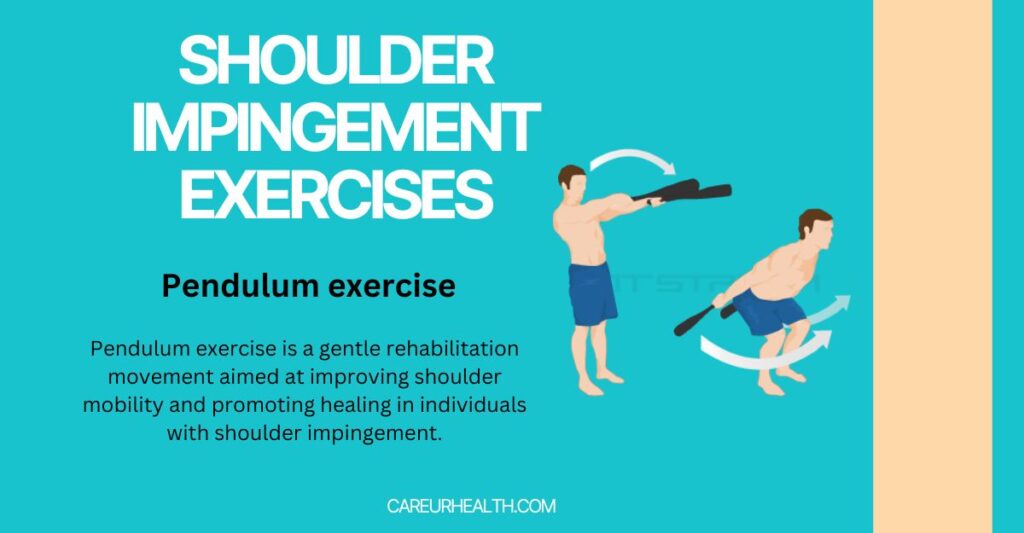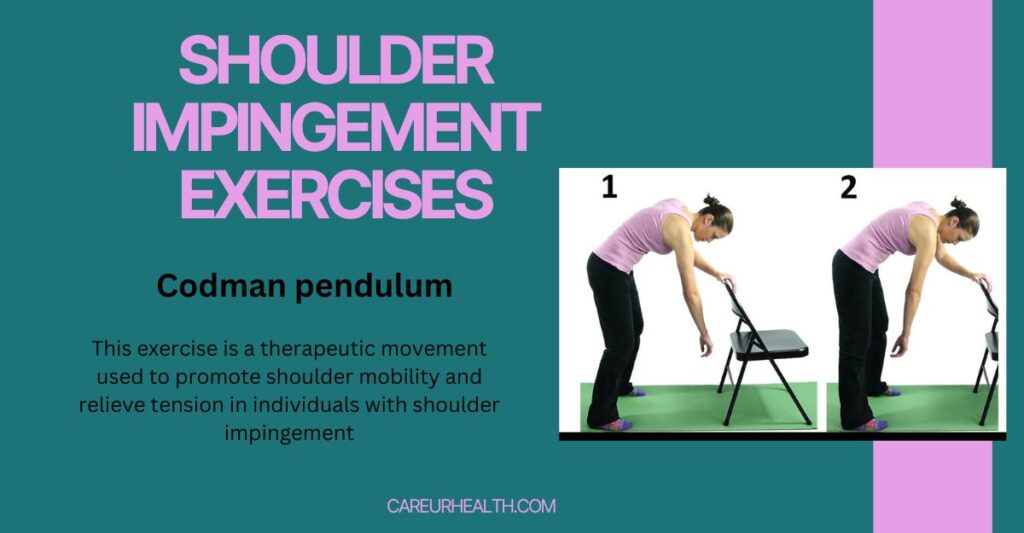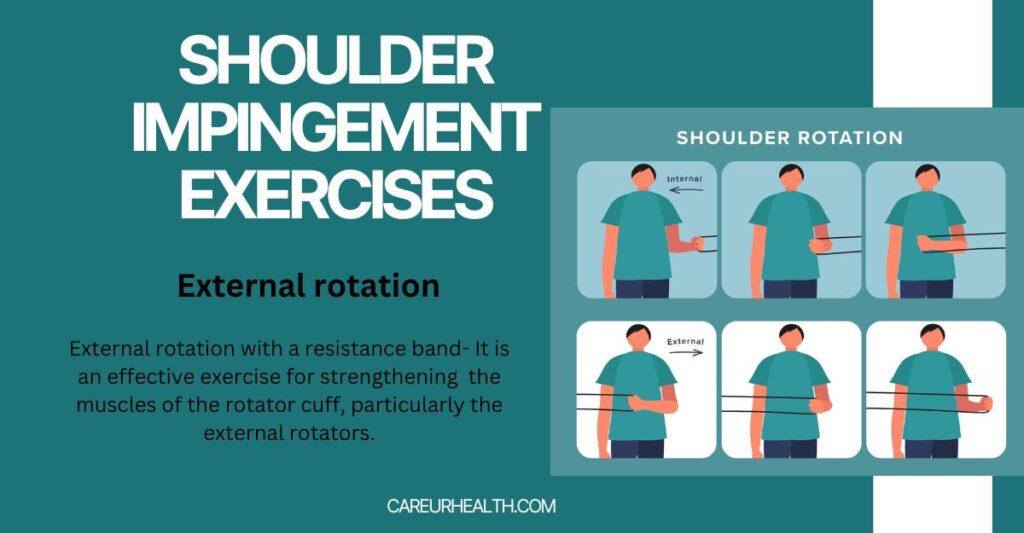Shoulder impingement syndrome is a common condition characterized by pain and weakness in the shoulder joint, particularly when raising the arm overhead. It occurs when the tendons of the rotator cuff muscles or the bursa become compressed or irritated, often due to repetitive overhead activities, poor posture, or muscle imbalances. Also this compression leads to inflammation, pain, and limited range of motion, affecting daily activities and quality of life. There are many shoulder impingement exercises.

- Also effective management of shoulder impingement involves a combination of conservative treatments, including exercises to strengthen the rotator cuff muscles, improve shoulder mobility, and correct posture.
- These exercises aim to alleviate pain, restore function, and prevent further injury by addressing underlying muscle imbalances and improving shoulder mechanics.
- Additionally, incorporating proper body mechanics and ergonomic modifications into daily activities can help reduce stress on the shoulder joint and promote healing. Also by implementing a comprehensive approach that combines targeted exercises, ergonomic adjustments, and activity modification, individuals with shoulder impingement can experience improved function and a return to pain-free movement.
1) Pendulum exercise-

Pendulum exercise is a gentle rehabilitation movement aimed at improving shoulder mobility and promoting healing in individuals with shoulder impingement. To perform this exercise, stand next to a table or chair for support, and lean forward slightly. Let your affected arm hang down naturally. Using your body’s momentum, gently swing your arm in small circles, first clockwise and then counterclockwise. The pendulum exercise helps to alleviate stiffness, reduce inflammation, and improve the range of motion in the shoulder, making it an essential component of a comprehensive shoulder impingement rehabilitation program. This is one of the shoulder impingement exercises.
2) Codman pendulum
This exercise is a therapeutic movement used to promote shoulder mobility and relieve tension in individuals with shoulder impingement. Also to perform this exercise, stand or sit with your unaffected arm supported on a table or chair. Allow your affected arm to hang freely by your side, completely relaxed. Using your body’s momentum, gently swing your arm back and forth in a pendulum-like motion, similar to a swinging pendulum clock. Also the movement should be smooth, controlled, and pain-free. The Codman pendulum exercise helps to increase blood flow to the shoulder joint, loosen tight muscles, and improve the range of motion. It is often recommended as part of a comprehensive rehabilitation program to aid in the recovery from shoulder impingement and restore functional mobility. Also this is one of the shoulder impingement exercises.

3) Scapular retraction
To perform this exercise, stand or sit with proper posture, keeping your spine neutral. Begin by squeezing your shoulder blades together as if you’re trying to hold a pencil between them. Also hold this position for a few seconds, focusing on engaging the muscles between your shoulder blades. Then, release and relax the shoulder blades. Repeat this movement for several repetitions. Scapular retraction helps to improve posture, shoulder stability, and overall shoulder function. Also by strengthening the muscles responsible for scapular movement, this exercise can help alleviate symptoms of shoulder impingement and prevent future injuries. This is one of the shoulder impingement exercises.
4) External rotation
External rotation with a resistance band- It is an effective exercise for strengthening the muscles of the rotator cuff, particularly the external rotators. Also to perform this exercise, anchor a resistance band at waist height and stand with your affected side facing the anchor point. Hold the band with your affected arm at a 90-degree angle, elbow close to your side, and palm facing inward. Keeping your elbow stationary, slowly rotate your forearm away from your body against the resistance of the band. Hold for a moment, then return to the starting position in a controlled manner. Also repeat for several repetitions. This exercise targets the external rotator muscles, helping to stabilize the shoulder joint and alleviate symptoms of shoulder impingement. Also gradually increase resistance as strength improves for continued progress.This is one of the shoulder impingement exercises.

5) Internal rotation
Internal rotation with a resistance band -It is a beneficial exercise for strengthening the muscles of the rotator cuff, particularly the internal rotators. Also to perform this exercise, anchor a resistance band at waist height and stand with your unaffected side facing the anchor point. Hold the band with your affected arm at a 90-degree angle, elbow close to your side, and palm facing outward. Also keeping your elbow stationary, slowly rotate your forearm towards your body against the resistance of the band. Hold for a moment, then return to the starting position in a controlled manner. Repeat for several repetitions. Also this exercise targets the internal rotator muscles, aiding in shoulder stability and helping to alleviate symptoms of shoulder impingement. Adjust resistance as needed to challenge the muscles appropriately. This is one of the shoulder impingement exercises.
6) Wall angels–
Wall angels are a valuable exercise for improving shoulder mobility, and posture and strengthening the muscles around the shoulder blades. To perform wall angles, stand with your back against a wall, ensuring that your head, upper back, and hips are in contact with the wall. Bend your elbows to 90 degrees, with your arms forming a “goalpost” position and your palms facing forward. Slowly slide your arms up the wall, maintaining contact between your elbows, wrists, and back. Aim to reach as high as possible without lifting your elbows or losing contact with the wall. Then, slowly lower your arms back down to the starting position. Wall angles help to correct rounded shoulder posture and reduce the risk of shoulder impingement by improving scapular movement and shoulder mobility. Repeat for several repetitions, focusing on controlled movements and proper form.This is one of the shoulder impingement exercises.

7) YTWL
To perform the YTWL exercise, lie face down on an exercise ball or bench with your arms hanging down towards the floor. Begin by forming the shape of the letter “Y” with your arms by lifting them up and out to the sides, while keeping your thumbs pointing towards the ceiling. Then, move into a “T” position by extending your arms straight out to the sides, palms facing down. Next, form a “W” by bending your elbows and pulling them towards your sides, squeezing your shoulder blades together.
Finally, move into an “L” position by bending your elbows to 90 degrees and lifting your arms towards the ceiling. Focus on maintaining proper form and engaging the muscles between your shoulder blades throughout the exercise. Repeat the sequence for several repetitions to strengthen the muscles responsible for shoulder stability and help prevent shoulder impingement.This is one of the shoulder impingement exercises.
Conclusion
Shoulder impingement syndrome is a common condition characterized by pain, weakness, and limited range of motion in the shoulder joint. Effective management often involves a combination of exercises aimed at strengthening the rotator cuff muscles, improving shoulder mobility, and correcting posture. By incorporating exercises such as pendulum movements, scapular retractions, external and internal rotations with resistance bands, wall angels, and the YTWL exercise, individuals can promote healing, reduce pain, and restore function to the shoulder. There are many shoulder impingement exercises. Consistency and proper technique are essential for achieving optimal results. Additionally, it’s crucial to listen to your body and avoid exercises that exacerbate symptoms. Seeking guidance from a physical therapist or healthcare professional can provide personalized recommendations and ensure safe and effective rehabilitation. With dedication to a comprehensive exercise program, individuals with shoulder impingement can experience improved shoulder health and a better quality of life.
Frequently Asked Questions (FAQs)
What are shoulder impingement exercises?
Shoulder impingement exercises are specifically designed movements aimed at relieving pain and improving mobility in the shoulder joint by reducing impingement of soft tissues.
What causes shoulder impingement?
Shoulder impingement can be caused by repetitive overhead movements, poor posture, muscle imbalances, or structural issues in the shoulder joint.
Are there specific exercises to avoid with shoulder impingement?
Yes, exercises that involve repetitive overhead movements or extreme shoulder abduction can aggravate shoulder impingement. It’s important to consult with a healthcare professional for personalized advice.
What are some common shoulder impingement exercises?
Common exercises include shoulder external rotation with a resistance band, scapular stabilization exercises, rotator cuff strengthening exercises, and stretches to improve shoulder flexibility.
How often should I do shoulder impingement exercises?
It’s best to start with a few times per week and gradually increase frequency as tolerated. Listen to your body and avoid overdoing it, especially if you experience increased pain or discomfort.
Can shoulder impingement exercises be done at home?
Yes, many shoulder impingement exercises can be done at home with minimal equipment, such as resistance bands or light dumbbells. However, it’s important to learn proper form to avoid injury.
How long does it take to see results from shoulder impingement exercises?
Results vary depending on the severity of the impingement and consistency of exercise. Some people may experience relief within a few weeks, while others may take longer. Patience and consistency are key.
Should I do shoulder impingement exercises if I’m in pain?
It’s important to distinguish between discomfort associated with exercise and pain that worsens during or after activity. If you experience increased pain during exercises, stop and consult with a healthcare professional.
Are there any alternative treatments for shoulder impingement?
In addition to exercises, alternative treatments may include physical therapy, manual therapy, corticosteroid injections, or in severe cases, surgery.
Can shoulder impingement exercises prevent future injuries?
Yes, performing regular shoulder impingement exercises can help improve shoulder strength, stability, and mobility, reducing the risk of future injuries. It’s important to maintain proper form and technique to maximize benefits.
AskDoctorJo










